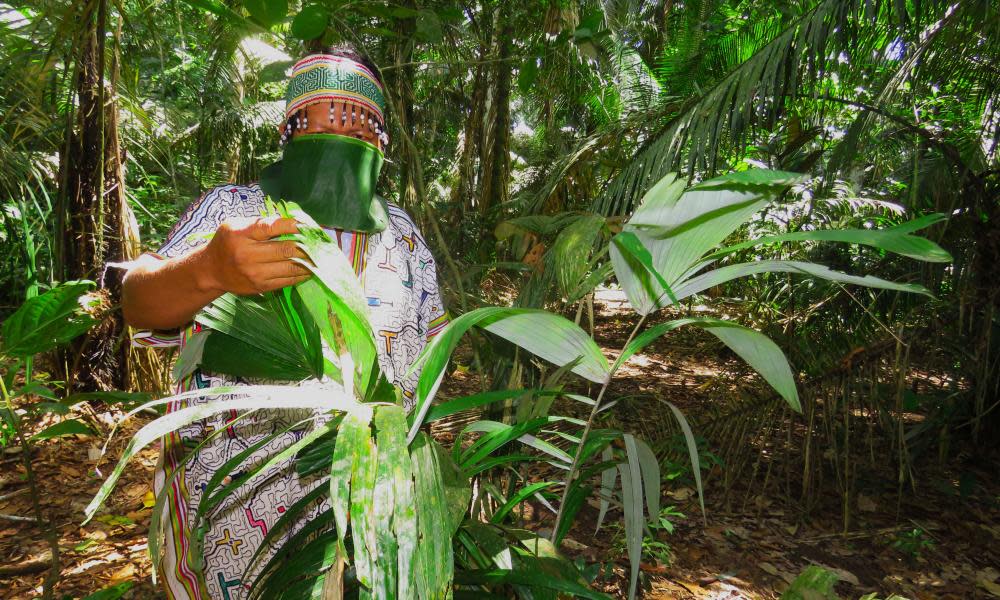Alarm as Covid-19 reaches recently contacted Amazon tribe

The Covid-19 virus has reached a remote reserve for recently contacted indigenous people in the Peruvian Amazon, despite efforts to shield the extremely vulnerable population from the pandemic.
Related: 'Coronavirus could wipe us out': indigenous South Americans blockade villages
At least six coronavirus cases have been recorded among the Nahua people, who have lived mostly in voluntary isolation since they were first contacted in the 198os. Fewer than a thousand members of the group live in the Kugapakori-Nahua-Nanti territorial reserve, an expanse of 4,556 sq km (1,763 sq miles) in Peru’s southern Amazon.
The report has prompted alarm among Amazon indigenous activists who have repeatedly warned that coronavirus could cause a disastrous repeat of previous pandemics that devastated their populations.
The Covid-19 cases were focused in Santa Rosa de Serjali, a settlement of 391 Nahua people which has been in “initial contact” with the outside world for three decades, according to Peru’s culture ministry.
Health workers have visited and seven tonnes of food along with masks and other supplies have been left at the community, the ministry reported.
A 47-year-old non-indigenous man, the partner of a Nahua woman, was reportedly the first community member to show symptoms of the virus. He was initially treated for a respiratory infection until he was taken to Sepahua, the nearest town, and diagnosed with Covid-19.
Health workers say the infection could become widespread among the Nahua, who often lack immunity to introduced diseases, even the common cold.
The Nahua were decimated by their first contact with outsiders in the mid-1980s when the colds, influenza and respiratory illnesses wiped out half of their population. Tests show that 80% of the population have levels of mercury in their bodies well above safe limits for reasons which are, as yet, unclear.
Health workers detected more than 150 Covid-19 cases among eight indigenous populations in Sepahua, which is believed to have been the point of infection for the Nahua. No deaths have been reported, according to a statement from the culture ministry.
Other remote communities on the border with Brazil have also reported coronavirus cases. Peru recognizes 20 indigenous groups in voluntary isolation and “initial contact”, numbering about 7,000 in total.
Indigenous groups protested about the lack of government attention this week. While there are no official numbers of coronavirus cases and deaths among Peru’s indigenous population, Aidesep, the umbrella Amazon indigenous federation said there were more than 15,000 cases and at least 500 deaths.
Related: ‘We are facing extermination’: Brazil losing a generation of indigenous leaders to Covid-19
In April, Aidesep accused the Peruvian state of “ethnocide by inaction” in a formal complaint to the UN and international courts for allegedly failing to adequately protect indigenous people from the coronavirus pandemic.
Covid-19 has already struck deep into isolated Amazon regions of Brazil, Colombia and Peru. The Pan-Amazonian Ecclesiastical Network, Repam, part of the Catholic church, reported 565,779 Covid-19 cases and 16,949 deaths across the rainforest region, which covers seven countries.
Peru is the fifth-worst-affected country in the world and second in Latin America, with 333,867 confirmed Covid-19 cases and 12,229 deaths on Wednesday, according to John Hopkins University.
The Financial Times recently reported that based on population size, Peru had one of the world’s highest excess mortality rates, measured as the number of deaths above the normal average number, during the pandemic period.

